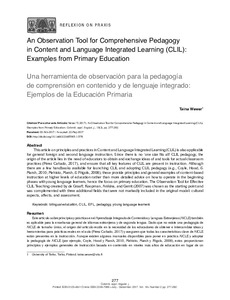An Observation Tool for Comprehensive Pedagogy in Content and Language Integrated Learning (CLIL): Examples from Primary Education - Una herramienta de observación para la pedagogía de comprensión en contenido y de lenguaje integrado: ejemplos de la educación primaria
Taina Wewer
An Observation Tool for Comprehensive Pedagogy in Content and Language Integrated Learning (CLIL): Examples from Primary Education - Una herramienta de observación para la pedagogía de comprensión en contenido y de lenguaje integrado: ejemplos de la educación primaria
Taina Wewer
Universidad Distrital Francisco Jose de Caldas, Maestria en Linguistica Aplicada
Julkaisun pysyvä osoite on:
https://urn.fi/URN:NBN:fi-fe2021042826871
https://urn.fi/URN:NBN:fi-fe2021042826871
Tiivistelmä
This article on principles and practices in Content and Language Integrated Learning (CLIL) is also applicable for general foreign and second language instruction. Since there is no 'one size fits all' CLIL pedagogy, the origin of the article lies in the need of educators to obtain and exchange ideas of and tools for actual classroom practices (Perez Canado, 2017), and ensure that all key features of CLIL are present in instruction. Although there are a few handbooks available for launching CLIL and adopting CLIL pedagogy (e.g., Coyle, Hood, & Marsh, 2010; Mehisto, Marsh, & Frigols, 2008), these provide principles and general examples of content-based instruction at higher levels of education rather than more detailed advice on how to operate in the beginning phases with young language learners, hence the focus on primary education. The Observation Tool for Effective CLIL Teaching created by de Graaff, Koopman, Anikina, and Gerrit (2007) was chosen as the starting point and was complemented with three additional fields that were not markedly included in the original model: cultural aspects, affects, and assessment.
Este artículo sobre principios y prácticas en el Aprendizaje Integrado
de Contenidos y Lenguas Extranjeras (AICLE) también es aplicable para la
enseñanza general de idiomas extranjeros y de segunda lengua. Dado que
no existe una pedagogía de AICLE de tamaño único, el origen del artículo
reside en la necesidad de los educadores de obtener e intercambiar
ideas y herramientas para prácticas reales en el aula (Pérez Cañado,
2017) y aseguren que todas las características clave de AICLE están
presentes en la instrucción. Aunque existen algunos manuales disponibles
para poner en práctica AICLE y adoptar la pedagogía de AICLE (por
ejemplo, Coyle, Hood y Marsh, 2010, Mehisto, Marsh y Frigols, 2008),
estos proporcionan principios y ejemplos generales de instrucción basada
en contenido en niveles más altos de educación en lugar de un
asesoramiento más detallado sobre cómo operar en las fases iniciales con
los estudiantes de idiomas jóvenes, por lo tanto, el enfoque en la
educación primaria. La herramienta de observación para la enseñanza
efectiva en CLIL creada por de Graaff, Koopman, Anikina y Gerrit (2007)
fue elegida como punto de partida y fue complementada con tres campos
adicionales que no fueron incluidos marcadamente en el modelo original:
aspectos culturales, afectos y evaluación.
de Contenidos y Lenguas Extranjeras (AICLE) también es aplicable para la
enseñanza general de idiomas extranjeros y de segunda lengua. Dado que
no existe una pedagogía de AICLE de tamaño único, el origen del artículo
reside en la necesidad de los educadores de obtener e intercambiar
ideas y herramientas para prácticas reales en el aula (Pérez Cañado,
2017) y aseguren que todas las características clave de AICLE están
presentes en la instrucción. Aunque existen algunos manuales disponibles
para poner en práctica AICLE y adoptar la pedagogía de AICLE (por
ejemplo, Coyle, Hood y Marsh, 2010, Mehisto, Marsh y Frigols, 2008),
estos proporcionan principios y ejemplos generales de instrucción basada
en contenido en niveles más altos de educación en lugar de un
asesoramiento más detallado sobre cómo operar en las fases iniciales con
los estudiantes de idiomas jóvenes, por lo tanto, el enfoque en la
educación primaria. La herramienta de observación para la enseñanza
efectiva en CLIL creada por de Graaff, Koopman, Anikina y Gerrit (2007)
fue elegida como punto de partida y fue complementada con tres campos
adicionales que no fueron incluidos marcadamente en el modelo original:
aspectos culturales, afectos y evaluación.
Kokoelmat
- Rinnakkaistallenteet [19207]
